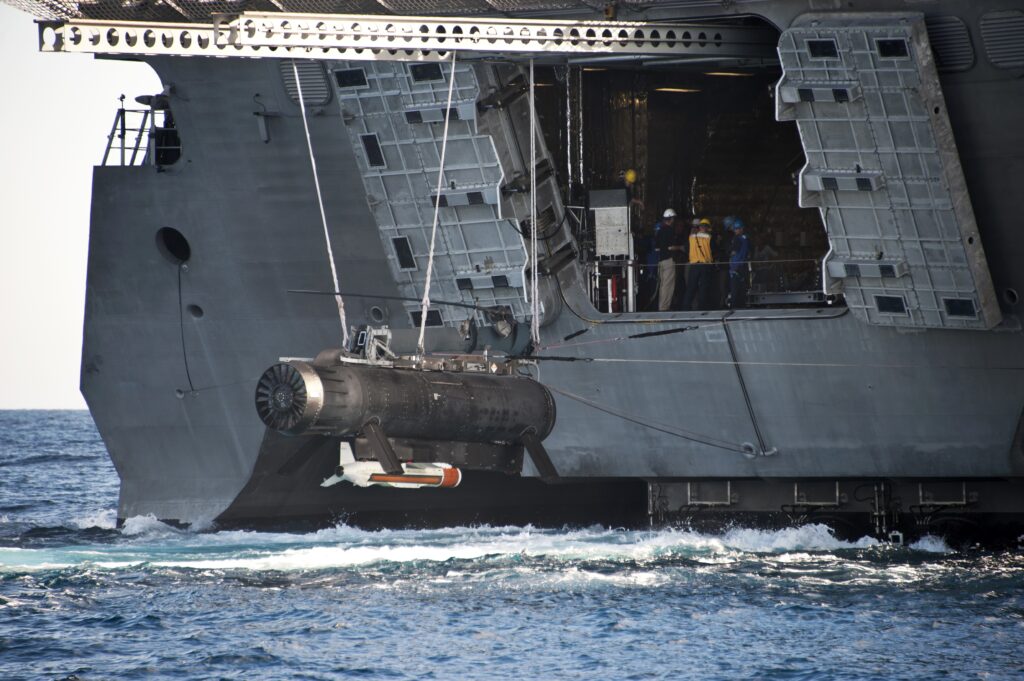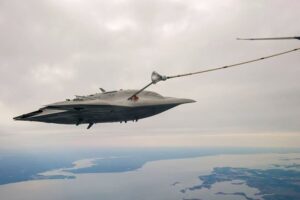
UPDATED with Lockheed response
WASHINGTON: The Navy will scrap the troubled RMMV drone meant to hunt mines from its controversial Littoral Combat Ships, replacing it with a different type of robot boat, Navy Secretary Ray Mabus said today.
That’s a decision a more responsive acquisition system would have made long ago, added Chief of Naval Operations, Adm. John Richardson. The CNO has pushed hard for a “speed lane” that succeeds — or fails — much faster than the existing bureaucracy. His high-profile pilot program for this fast track will be another drone: the Carrier-Based Aerial Refueling System (CBARS), a robot tanker which he wants on carrier decks as fast as possible so the fleet can experiment with prototypes in real-world conditions.

The issue here goes beyond the specific drones to the fundamental philosophy of the Pentagon acquisition system. By custom, policy, and often law, the current system is pathologically risk-averse. It drags out development for years trying to wring out every possible problem. When problems inevitably arise anyway, it clings to the current, faulty solution and tries to make it work rather than admit defeat by trying something new. That mentality means good technology takes too long to get to the force and bad technology takes too long to get rid of.
“We can’t be afraid of failing. Not everything is going to work,” said Gen. Robert Neller, Marine Commandant. “If we wait for it to be perfect, it’ll probably be overcome by something (newer) in 10 years.”
Neller, Richardson, and Mabus spoke side-by-side this morning at the Brookings Institution, a remarkable hat trick of naval leadership.
There are technologies out there with tremendous potential, said Mabus: unmanned and robotic systems, lasers, railguns, cyber, 3D printing. “The thing that I think concerns all of us is how long it takes to get those technologies to the warfighter,” he said, “how long it takes to go from lab to the fleet, and how convoluted the acquisition process is.”
“[So] we’re doing things like rapid prototyping,” Mabus continued. “Before you start a multi-year, multi-billion dollar program of record, you’ve got a prototype of a system, weapon, whatever, that you’ve done the initial testing on, [where] you believe the technology works: Get it out to the fleet and see in real-world conditions what are the issues, what are the problems.”
“So you succeed quicker — or you fail quicker,” Mabus said.
The Littoral Combat Ship is “a great example of … trying to get testing while you’re deploying and balancing that against the formal test procedures,” Mabus said. “There’s a huge demand for LCS.”
Six LCS of two different designs are now in service, even though formal operational testing is not complete, and they’ve done real-world deployments to Singapore, even though several LCS have had embarrassing mechanical problems. The argument in LCS’s favor would be that all new ship classes have flaws, and it’s better to find them out as fast as possible so they can be fixed.
One of the Littoral Combat Ship’s most important and most difficult missions is clearing minefields. LCS critics from Sen. John McCain on down have hammered a key component of the mine-warfare kit, a sonar-equipped mine-finding drone. The system is variously called the Remote Multi-Mission Vehicle (RMMV) or Remote Minehunting System (RMS). A “semi-submersible” drone that sticks just a small part of its body above water, RMMV is meant to combine the best features of boats and mini-subs, but its reliability falls far short: just 25 hours on average between breakdowns, compared to a minimum requirement of 75.
“On the minehunting [package], all the sensors work; this thing can find mines, it can fix them, and it can eliminate them. We are not satisfied with the reliability of the RMMV,” Mabus acknowledged. “We’ve got ten of these, we’re going to upgrade them to make ’em more reliable, but it’s not a long-term answer.”
Instead, “we’re going to move to something different,” Mabus said. “We’re going to move first to probably an unmanned surface vehicle, instead of this semi-submersible, and then we’re going to move longer-term to an unmanned underwater vehicle.”
Mabus didn’t name the robot boat that would replace RMMV, but a top contender is the Textron Common Unmanned Surface Vehicle. CUSV is already being added to the LCS mine warfare package in a different role, towing an “unmanned influence sweep system” to detonate mines at a distance. The roboboat is designed for multiple missions — hence the name “Common” — so it wouldn’t be a stretch to fit it with a sonar to find the mines in the first place.
“If we’d had a rapid prototyping approach earlier in this program, I think we would be in a different place with regard to this [RMMV],” added Adm. Richardson. “We would wrung that out a lot faster and we would have gone to a different solution earlier.”
Richardson wants CBARS “to be the poster child for how we should do acquisition” in a new, faster, more agile manner, he said. “We’re going to get something on deck as soon as we can, that will fulfill a valid need, for tanking and ISR [intelligence, surveillance, and reconnaissance],” he said. While that’s less ambitious than CBARS’s predecessor program for a robot bomber, the Unmanned Carrier-Launched Surveillance and Strike (UCLASS) effort, “nothing we’re going to do right now is going to preclude transitioning to a high-end type of capability” when the technology is ready, Richardson said.
But in the meantime, Richardson said, “we’re not going to wait and shoot the long shot from half court.” Instead, the Navy will put a less ambitious, more feasible, more affordable system — CBARS — in service faster so the fleet can start learning ASAP how to integrate drones into its carrier air wings.
“We’re gong to get the thing on deck, we’re going to start learning fast., and we’re going to be able to respond much more adroitly to whatever security challenges come down the pike,” Richardson said. And one day, he predicted, “we’re going to look back and say, ‘this is one of those programs that helped us into a new regime in terms of acquisition.'”
UPDATE BEGINS Lockheed Martin, which makes the RMMV/RMS mine-hunting drone, provided us the following statement in response to the original version of this article:
“We believe the Remote Minehunting System with today’s RMMV remains the most advanced method of minehunting available to meet the Navy’s mine reconnaissance mission as part of the LCS mine countermeasure (MCM) mission package.
“In 2015 the RMMV was tested within the LCS MCM mission package system of systems for the first time. The results demonstrated that RMS with RMMV not only finds mines, but test results confirmed that the mission package exceeded search rate goals with today’s RMMV. In other words, the system finds mines at a rate faster than required.
“Joint U.S. Navy and Lockheed Martin assessment teams largely attributed the RMMV reliability issues experienced during testing to mission package integration issues, vehicle configuration and maintenance shortcomings. Lockheed Martin recognizes the challenging role the Navy has as systems integrator for the mission packages and will continue to provide support including upgrading vehicles, establishing a class maintenance plan, resolving integration challenges, and training proficient operators and technicians to deliver a reliable RMMV system to the fleet.” END UPDATE

